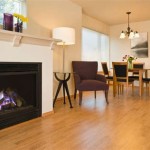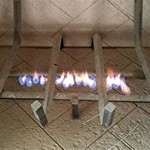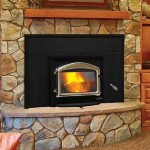Natural Fireplace Ideas: Integrating Nature into Your Hearth
The fireplace has long served as a central gathering point within the home, providing warmth, light, and a sense of comfort. As design trends shift towards embracing natural elements and sustainable practices, incorporating natural materials into fireplace design has gained significant popularity. This approach seeks to move beyond purely functional considerations and to create a visually appealing and environmentally conscious focal point that harmonizes with the surrounding environment.
Natural fireplaces utilize a range of materials sourced directly from nature, or processed minimally to retain their inherent characteristics. These materials can include various types of stone, wood, and even living plants. The selection and application of these elements require careful planning and execution to ensure both aesthetic appeal and functional safety.
Stone as a Foundation: Exploring Natural Stone Options
Stone is perhaps the most classic and widely used natural material in fireplace construction. Its inherent durability, thermal properties, and aesthetic diversity make it an ideal choice for both structural and decorative purposes. The selection of stone involves considering factors such as color, texture, shape, and size, as well as the overall design aesthetic of the room.
Fieldstone, often sourced directly from local fields or quarries, offers a rustic and irregular appearance that evokes a sense of history and connection to the surrounding landscape. Its varied shapes and sizes create a visually dynamic surface, ideal for fireplaces in country homes or cabins. The installation of fieldstone requires skilled craftsmanship to ensure proper fitting and stability.
River rock, characterized by its smooth, rounded shapes, provides a more refined and contemporary feel. Often sourced from riverbeds, these stones are naturally polished by water, creating a tactile and visually appealing surface. River rock can be used to create a sleek and minimalist fireplace surround, or incorporated as an accent element within a larger design.
Flagstone, a sedimentary rock that splits into flat layers, is another popular choice for fireplace facings. Its natural variations in color and texture add depth and character, while its flat surface makes it relatively easy to install. Flagstone is available in a range of colors, from earthy browns and grays to vibrant reds and oranges.
Slate, a fine-grained metamorphic rock, offers a sophisticated and contemporary aesthetic. Its smooth, dark surface creates a dramatic contrast with the flames of the fire. Slate is highly durable and resistant to heat, making it a practical and visually appealing choice for modern fireplace designs.
Limestone, a sedimentary rock composed primarily of calcium carbonate, provides a light and airy feel. Its soft, porous texture can be easily carved and shaped, making it ideal for creating intricate details and decorative elements. Limestone is available in a range of colors, from creamy whites to light beiges and grays.
Granite, an igneous rock known for its exceptional durability and strength, is a premium choice for fireplace construction. Its speckled appearance and wide range of colors add visual interest, while its resistance to heat and scratching ensures long-lasting performance. Granite is often used in high-end homes and commercial settings.
Regardless of the type of stone selected, proper installation is crucial to ensure the safety and longevity of the fireplace. A professional mason should be consulted to assess the structural integrity of the existing fireplace and to ensure that the stone is properly anchored and sealed.
Wood as an Accent: Integrating Natural Wood Elements
In addition to stone, wood can be incorporated into fireplace design to add warmth, texture, and a touch of natural beauty. Wood can be used as a mantel, a surround, or even as a decorative element within the firebox itself. The choice of wood species will influence the overall aesthetic of the fireplace, with different types of wood offering varying colors, grains, and textures.
Reclaimed wood, sourced from old barns, factories, or other structures, offers a unique and sustainable option for fireplace design. Its weathered appearance and history add character and charm, while its use helps to reduce waste and conserve natural resources. Reclaimed wood can be used to create a rustic mantel, a distressed surround, or even a decorative accent wall behind the fireplace.
Live edge wood, characterized by its natural, un-sanded edges, provides a raw and organic feel. Its irregular shapes and textures create a striking contrast with the clean lines of modern fireplaces. Live edge wood can be used to create a unique mantelpiece or a decorative panel that adds visual interest to the fireplace surround.
Driftwood, sourced from beaches and waterways, offers a unique and weathered appearance that evokes a sense of coastal living. Its smooth, gray surface and interesting shapes make it ideal for creating a decorative mantel or a sculptural accent piece. Driftwood should be properly cleaned and treated before being used in a fireplace design to prevent decay and insect infestation.
Natural wood mantels add a warm and inviting element to any fireplace. The choice of wood can range from traditional hardwoods like oak and maple to more exotic species like walnut and cherry. The mantel can be stained or sealed to enhance its natural beauty and protect it from moisture and wear.
Considerations for using wood near a fire source must prioritize safety. All wood elements must be properly treated with fire-retardant chemicals, and clearances from the firebox must adhere to local building codes. Regular inspections are imperative to ensure the long-term safety and performance of the wood elements.
Living Fireplaces: Integrating Nature Through Plants
A more unconventional, yet increasingly popular, approach to natural fireplace design involves integrating living plants into the overall aesthetic. This can be achieved through various methods, such as incorporating potted plants around the fireplace, creating a green wall above the mantel, or even designing a firebox with integrated planters.
Planting drought-tolerant succulents around the fireplace surround can add a touch of greenery and texture without requiring excessive maintenance. Succulents are well-suited to the dry conditions typically found near fireplaces and come in a variety of shapes, sizes, and colors.
Creating a vertical garden or green wall above the mantel can transform the fireplace into a living work of art. This can be achieved by installing a modular system with individual planters or by creating a custom framework to support the plants. The plants can be selected based on their aesthetic appeal, their ability to purify the air, and their tolerance to the heat from the fireplace.
Moss walls offer a unique and low-maintenance option for adding greenery to the fireplace area. Preserved moss requires no watering or sunlight and provides a soft, textural element that complements the natural materials used in the fireplace design. Moss walls can be customized to create various patterns and designs, adding a touch of whimsy and natural beauty to the space.
Incorporating aromatic herbs such as lavender, rosemary, or thyme around the fireplace can add a pleasant scent to the room and create a relaxing atmosphere. These herbs can be planted in pots or containers and placed strategically around the fireplace to release their fragrance when warmed by the fire.
Considerations for plant selection should include the ambient light, temperature, and humidity levels near the fireplace. Regular watering, pruning, and fertilization are essential to ensure the health and vitality of the plants. Additionally, care should be taken to prevent flammable plant materials from coming into direct contact with the fire.
The integration of natural fireplace ideas provides numerous benefits, extending beyond mere aesthetics. It connects individuals with the natural world, fostering a sense of tranquility and well-being. The careful selection and integration of materials can contribute to a healthier indoor environment by reducing reliance on synthetic materials. By embracing natural elements, the fireplace can evolve from a simple source of heat into a holistic design feature that enhances the overall living space.

Stone Veneer Fireplace Ideas That Will Warm Up Your Home Ply Gem

25 Stone Fireplace Ideas For A Cozy Nature Inspired Home Surround Country

Fireplace Ideas The Home Depot

50 Fireplace Ideas To Give Your Room That Special Spark

20 Living Room Fireplace Ideas And Trends For A Charming Interior

Home Fireplace House Design Natural Stone Fireplaces

9 Indoor Fireplaces That Will Bring Warmth And Charm To Your Home Swenson Granite 100 Natural Stones

Stone Fireplace Mod Home Info Natural Fireplaces Cabin Decor White

20 Rustic Stone Fireplace Ideas For Design Inspiration Field Mag

Stone Veneer Interior Design Living Room Kitchen Bedroom Ideas More Buechel
Related Posts








